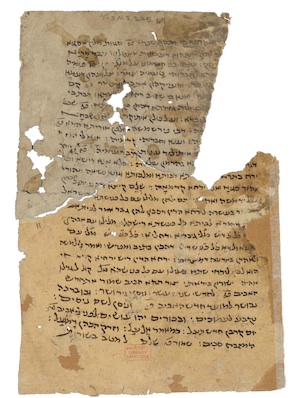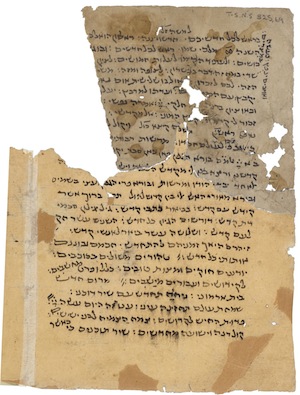Additional Fragments Belonging to the First Order of Fustat
By Michael Rand
In 1968, in an article entitled ראש ראשי חדשים, Ezra Fleischer called attention to the existence in the Genizah of an order of prayer containing elements of the Palestinian liturgical rite, the main part of the text being preserved as T‑S H12.11. This manuscript consists of three consecutive bifolia, all belonging to the same quire. As will become evident presently, if we assume that the original quire consisted of five bifolia, then the quire represented by T‑S H12.11 is lacking the innermost and the outermost bifolia, with the result that the three preserved bifolia fall into two groups, each consisting of three consecutive leaves. The proper ordering of the three existing bifolia is given in the facsimile of the manuscript published at the end of Fleischer 1988. The final section in the second group of three leaves is devoted to a qiddush ceremony in honour of the New Moon of Nisan, which is known as ראס אלהלאל אלכביר, ‘the Great New Moon’. This ceremony is peculiar to the Palestinian liturgical rite, and is characterised by the use of an eclectic plethora of liturgical poems in honour of Nisan.
In the same 1968 article, Fleischer also published material from an additional manuscript belonging to the same order of prayer, T-S 13H3.11. The item is a single bifolium, only the bottom halves of whose two leaves are preserved. The first leaf contains material for the New Moon of Nisan, which belongs after the material contained in T-S H12.11. This is the leaf published by Fleischer. The second leaf contains the remains of text in the preserved recto, while the rest of the recto and the entire preserved verso are left blank. The preserved top of the recto of the leaf published by Fleischer contains the tail end of an Aramaic poem describing a precedence dispute between the months. The preserved top of the verso consists of a portion of the text containing the benedictions on wine, etc. pertaining to the actual qiddush ceremony.
In a follow-up article (1981) Fleischer published further material for the qiddush of the New Moon of Nisan from another leaf belonging to the same order of prayer, Mosseri VIII.394. This leaf is the direct continuation of the leaf published by him from T‑S 13H3.11.
In yet a third article (1991) Fleischer published material from T-S NS 236.5, which parallels the material for the New Moon of Nisan contained in the order of prayer that is described above. This manuscript contains, inter alia, the first part of a poetic precedence dispute between the months, איתחברו ירחי שתא, composed in Aramaic by Sahlān b. Avraham, who was active in the Babylonian community of Fusṭāṭ in the beginning of the eleventh century. The poem’s continuation is published in the same article from two manuscripts, which constitute portions of two consecutive leaves, T-S NS 125.96, followed by T-S NS 325.69. What escaped Fleischer’s notice at the time, and has become evident in the course of preparing a new critical edition of Sahlān’s poem, is the fact that T-S NS 325.69 is the missing upper portion of the first leaf of T-S 13H3.11. This being the case, it is now evident that T‑S NS 125.96 and T‑S NS 325.69 also belong to the same order of prayer.
In a final treatment of the subject (1993), Fleischer summarised his findings, naming the order of prayer under discussion here ‘The First Order of Fusṭāṭ’ (סדר פוסטאט א). In a further important development, he was also able to identify the compiler/copyist of this work as Yedutun ha-Levi. Yedutun was the cantor of the Palestinian synagogue in Fusṭāṭ (the Ben Ezra Synagogue), who devoted his unflagging energies to a last, unsuccessful, attempt at saving the remaining vestiges of the Palestinian liturgical rite from being replaced in favour of the triumphant Babylonian liturgy, the pro-Babylonian campaign being championed by Avraham, the son of Maimonides (for a summary of Yedutun’s career see Elizur 2009/2010). Yedutun’s partisan activities have left a significant trace in the form of various documents found in the Genizah, as well as several liturgical compilations, one of which is the First Order of Fusṭāṭ. These latter works are of great importance in documenting various aspects of the Palestinian liturgical rite.
Let us now summarise the known fragments of the First Order of Fusṭāṭ. In its current form, the work consists of two adjacent quires, both incomplete. The bulk of the first quire is represented by T‑S H12.11, containing the three middle bifolia of the original quire. The inner bifolium of this quire is missing, while the outer bifolium is represented by one leaf, this being the last leaf of the quire: T‑S NS 125.96. The outer bifolium of the following quire is preserved as T‑S 13H3.11, the upper portion of whose first leaf is completed by T‑S NS 325.69. That this is in fact the outer bifolium of the quire is indicated by the fact that its second leaf is empty in the bottom of the recto and in the verso. Presumably, this is the last leaf of the entire codex—and therefore, by implication, of the last quire in the codex—left blank by Yedutun, perhaps so as to be filled in with additional material as the occasion arose. The first leaf of this quire is followed by a second leaf, Mosseri VIII.394.
The composite image of T‑S 13H3.11 and T‑S NS 325.69 helps to establish the texts copied in the recto and verso of the leaf, respectively, in the area of the join. As indicated above, the recto in the joined area of the leaf contains the end of an Aramaic dispute poem by Sahlān ben Avraham (see image 1). I intend to publish a new critical edition of this poem in the near future: ‘An Aramaic Dispute between the Months by Sahlan ben Avraham’, Melilah (forthcoming).
Image 1: composite of T-S 13H3.11 and T-S NS 325.69, recto, a leaf from the First Order of Fustat, showing the end of Sahlān b. Avraham’s poem
The area of the join in the verso contains the text of the festive qiddush for the New Moon of Nisan (see image 2). The two parts of this text were published separately by Fleischer from the two separate fragments of the leaf, Fleischer 1968, p. 274 (from T-S 13H3.11) and Fleischer 1991, p. 56 (from T-S NS 325.69). The following is a transcription of this text on the basis of the composite image (angled brackets indicate interlineal text).
1 ויקול ל[.. ... ... ... ... ... ...]
2 כי טוב <יגיבו> כי לעולם חסדו. מרשות רבותיי [... ... ... ... ... ... ... ...]
3 ב' א' ייָי אל' מ' ה' בורא הגפן. פאן כאן שבת יקו[ל ... ... ... ...]
4 קדשנו ורצה בנו [א]לי מקדש השבת ויש[ראל ... ... ... ... ליל]ה
5 אלאחד יבדי הודו ומרשות ובורא פרי הגפן ועצי בשמים
6 ובורא מאורי האש אלי בין קדוש לחול. תם בָּרוּךְ אֲשֶׁר
Notes
Line 3: בורא הגפן] Fleischer’s surmise that the word פרי has been erroneously omitted by the scribe is now confirmed by the fact that the expected benediction formula, בורא פרי הגפן, occurs in line 5.
Line 5: יבדי] ‘He begins’. In his publication of the upper fragment, Fleischer tentatively suggested that the word be restored as יבדיל. The composite image conclusively precludes this restoration.
Line 6: ברוך אשר] The opening words of a poetic qiddush (see Fleischer 1968, p. 274–275).
Image 2: composite of T-S 13H3.11 and T-S NS 325.69, verso
Bibliography
Elizur, Sh. שירי ר' ידותון הלוי החבר in Diné Israel – Studies in Halakhah and Jewish Law 26–27 (2009/2010), pp. 301–308 [Hebrew section].
Fleischer, E. ראש ראשי חדשים, Tarbiz 37 (1968), pp. 265–278.
Fleischer, E. חדשות לעניין ראש ראשי חדשים in J. J. Petuchowski and E. Fleischer (eds), Studies in Aggadah, Targum and Jewish Liturgy in Memory of Joseph Heinemann (Jerusalem, 1981), pp. 111–132 [Hebrew section].
Fleischer, E. תפילה ומנהגי תפילה ארץ-ישראליים בתקופת הגניזה (Jerusalem, 1988).
Fleischer, E. עוד לעניין ראש ראשי חודשים, Sidra 7 (1991), pp. 49–65.
Fleischer, E. לסדרי התפילה בבית הכנסת של בני ארץ-ישראל בפוסטאט בראשית המאה השלוש עשרה, Asufot 7 (1993), pp. 217–260.
Cite this article
(2011). Additional Fragments Belonging to the First Order of Fustat. [Genizah Research Unit, Fragment of the Month, November 2011]. https://doi.org/10.17863/CAM.58102
If you enjoyed this Fragment of the Month, you can find others here.
Contact us: genizah@lib.cam.ac.uk
The zoomable images are produced using Cloud Zoom, a jQueryimage zoom plugin:
Cloud Zoom, Copyright (c) 2010, R Cecco, www.professorcloud.com
Licensed under the MIT License


